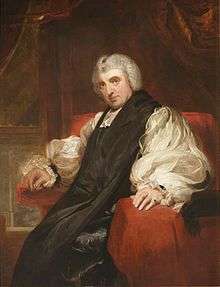George Huntingford
| The Right Reverend George Huntingford | |
|---|---|
| Bishop of Hereford | |
 | |
| Diocese | Diocese of Hereford |
| In office | 1815–1832 |
| Predecessor | John Luxmoore |
| Successor | Edward Grey |
| Other posts | Bishop of Gloucester (1802–1815) |
| Personal details | |
| Born |
9 September 1748 Winchester |
| Died |
29 April 1832 (aged 83) Winchester College |
| Nationality | British |
| Denomination | Anglican |
| Education | Winchester College |
| Alma mater | New College, Oxford |
George Isaac Huntingford (1748–1832) was successively of Bishop of Gloucester and Bishop of Hereford.
Life
Huntingford was educated at Winchester College and New College, Oxford, where he became a Fellow in 1770, graduating M.A., 1776 and D.D. in 1793. He was then curate of Compton, south of Winchester, before becoming a master of his old school, of which he was warden from 1780 until his death. During this time there was considerable disorder in the school, including two rebellions.
Through his friendship with Henry Addington, who he had taught at Winchester, Huntingford became Bishop of Gloucester, 1802–1815, and of Hereford, 1815–32, but continued to live in the comfortable Warden's lodgings at the school.
He compiled an account of his friend Henry Addington's administration, 1802; published also Short Introduction to Writing of Greek (frequently reissued), original Latin and Greek verse, and pamphlets.
From 1789 until 1825 he was vicar of the Church of St John the Evangelist, Milborne Port.[1]
References
-
 This article incorporates text from a publication now in the public domain: "Huntingford, George Isaac". Dictionary of National Biography. London: Smith, Elder & Co. 1885–1900.
This article incorporates text from a publication now in the public domain: "Huntingford, George Isaac". Dictionary of National Biography. London: Smith, Elder & Co. 1885–1900.
Further reading
- Bell, A., "Warden Huntingford and the Old Conservatism", Winchester College: Sixth Centenary Essays (ed. Custance), Oxford 1982
| Church of England titles | ||
|---|---|---|
| Preceded by Richard Beadon |
Bishop of Gloucester 1802–1815 |
Succeeded by Henry Ryder |
| Preceded by John Luxmoore |
Bishop of Hereford 1815–1832 |
Succeeded by Edward Grey |